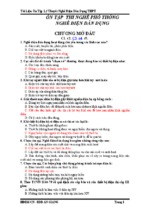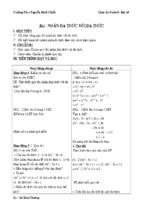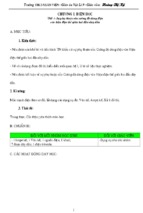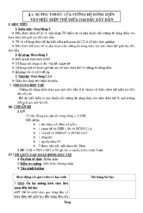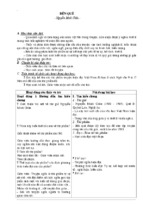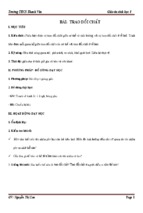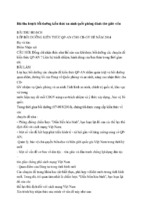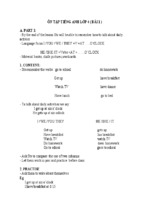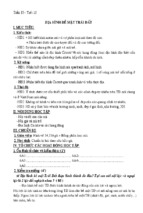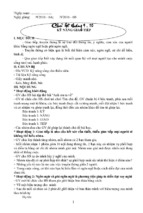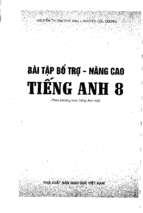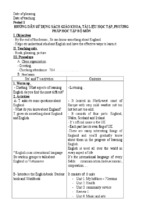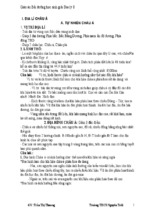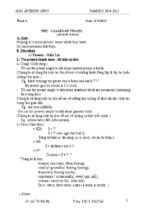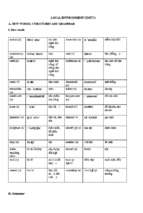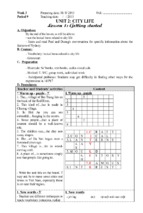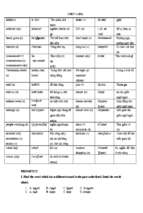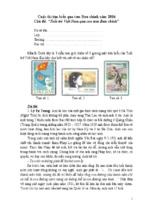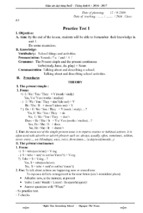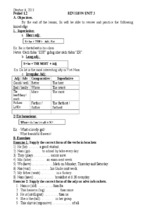Period: 2
Teaching date: 23/8/2016
Week: 1
Class: 9/1, 9/2
Unit 1: LOCAL ENVIRONMENT
Lesson 1 - GETTING STARTED: A visit to a traditional craft village
I. OBJECTIVES:
By the end of this Unit, students will be able to:
Use some vocabularies and structures to talk about traditional crafts and places of interest
in an area
II . PREPARATION: sub -board, pictures, cassette
III. PROCEDURES:
Teacher’s and students’ activities
Activity 1:
-Ask Ss to open their books and look at the picture and the
phrase under GETTING STARTED. Ask them some questions:
"Who and what can you see in the picture?"
"Where are they?"
"What do you think the people in the picture are talking
about?"
-Ss answer the questions as a class. If they mention 'Bat Trang',
elicit what they know about this village.
-Play the recording and have Ss follow along. After that, Ss can
compare their answers with the information in the dialogue and
add some more details to their answers.
a/.Ss work independently to find the words with the given
meanings in the dialogue. Allow Ss to share their answers before
asking them to discuss as a class. Remember to ask Ss to read
out the lines in the dialogue that contain the words. Quickly
write the correct answers on the board.
-Have Ss look at the Watch out! box and quickly read the
information. Tell them that there are some similar expressions
such as 'as far as I can remember', 'as far as I can see', or 'as far
as I can tell'.
b/.Have Ss read the questions to make sure they understand
them. Ask them firstly to answer the questions without reading
the dialogue again. Ss exchange their answers with a classmate.
Now ask them to check their answers by reading the dialogue
again. Ask for Ss' answers.
Activity 2:
-Have Ss look at the pictures. Tell Ss that in the box are some
traditional handicrafts of different regions in Viet Nam. Ss
match these handicrafts with the pictures. Ss compare their
answers in pairs before giving their answers to T:
Activity 3:
1
Content
1.
2.
3.
4.
5.
6.
7.
8.
craft
set up
take over
artisans
attraction
specific region
remind
look round
1.They are at Phong’s grandparents’ workshop in Bat Trang
2. It’s about 700 years old.
3. His great-grandmother did.
4. buy things for their house and
make pottery themselves there.
5. It’s in Hue.
6. … the handicrafts remind
them of a specific region.
A. paintings
B. drums
C. marble sculptures D. pottery
E. silk
F. lacquerware
G. conical hats H. lanterns
-Tell Ss to complete the sentences with the words/phrases in The
complete sentences will give Ss information about the places
where the handicrafts are made. Call on two Ss to write their
answers on the board. Confirm the correct answers.
-If time allows, T may organise a short activity to check Ss'
short-term memory. Have -Ss close their books. Point at each of
Ss' answers on the board and quickly Ss have to call out the
place where this handicraft is made. Ss can also be asked to
share any other places that produce these handicrafts.
Activity 4:
a/Ss work in pairs to do the quiz. The pair which has the
answers the fastest is invited to read out their answers. Elicit
feedback from other pairs. Confirm the correct answers.
b/Ss work in groups to write a similar quiz about places of
interest. Set a time limit of about five to seven minutes. When
time is up, ask the first group to read out a question in their quiz.
Ss from other groups give the answer. The group confirms the
correct answer. The second group then reads out a question in
their quiz. This question should be different from the one of the
first group. Continue the activity until all the groups have read
out all of their questions or when time is up.
IV- HOMEWORK:
-Practice reading the dialogue.
-Write new words then learn them by heart.
-Copy the exercise into notebooks.
-Prepare A CLOSER LOOK 1
Period: 3
Week: 1
2
1.
2.
3.
4.
5.
6.
conical hat
lanterns
silk
paintings
Pottery
marble sculptures
1.
2.
3.
4.
5.
park
museum
zoo
beach
beauty spot
Teaching date: 23/8/2016
Class: 9/1, 9/2
Unit 1: LOCAL ENVIRONMENT
Lesson 2 – A CLOSER LOOK 1
I. OBJECTIVES:
By the end of this Unit, students will be able to:
Use the lexical items related to traditional crafts and places of interest in an area
Say sentences with correct stress on the content words
II . PREPARATION: sub -board, pictures, cassette
III. PROCEDURES:
Teacher’s and students’ activities
Activity 1:
-Ss work individually to do this exercise and then
compare their answers with a classmate. Elicit the
answers from Ss and quickly write them on the board.
Do not confirm the correct answers at this stage. Have
Ss explain the meaning of each verb in English or
Vietnamese. Correct Ss' explanations when needed. The
two verbs cast and mould are quite difficult, so make
sure that Ss understand them: - cast: shape hot liquid
metal, etc. by pouring it into a container - mould: shape
a soft substance into a particular form or object by
pressing it or by putting it into a mould Now have Ss
look at their answers on the board and say if these are
correct..
Activity 2:
a/The purpose of this exercise is to help Ss understand
more deeply and use the verbs correctly to talk about
producing and creating crafts. Ss work in pairs to do the
exercise. Check the answers as a class. If time allows,
have Ss make sentences.
b/ This activity will help Ss to manipulate the verbs as
they are not all regular. Have Ss do the activity, then call
two Ss to write their answers on the board. Elicit
feedback from other Ss. Confirm the correct answers.
-Draw Ss' attention to the Watch out! box. Ask Ss to
give example sentences with the verb to make.
Activity 3:
-Organise a competition for this activity. Ss work in
groups of five or six. Set a time limit of five minutes. T
may prepare some large pieces of paper for the groups
to write their answers on. Ss write down as many places
of interest in the word web as possible. The group with
the most places is the winner. The winning group
presents their words/phrases. Other groups tick the
3
Content
A.
B.
C.
D.
E.
F.
G.
cast
carve
embroider
weave
mould
weave
knit
1.b
2.d
3.e
4.a
5.f
6.c
2. cast; cast
3. wove; woven
4. embroidered; embroidered
5. knitted; knitted
6. moulded; moulded
Entertaining: cinema, theatre…
Cultural: opera house, museum…
Educational: library, museum…
Historical: temples, craft village…
similar words/phrases they have and add more if they
can. If time allows, T may ask Ss to explain why they
think the places are entertaining, cultural, educational,
or historical.
Activity 4:
Ss individually do the exercise. Check their answers as a
class and confirm the correct ones.
Activity 5:
a/Have Ss read the five sentences and underline the
words they think are stressed. Elicit answers from Ss.
Do not confirm the correct answers. Now ask Ss to read
the four questions and make sure they understand them.
Ask Ss to listen to the speaker read the sentences and at
the same time check whether their answers are correct.
Tell them that this is actually the first question and other
questions can be answered after listening. Ss discuss
their answers to the four questions in pairs.
b/Call some Ss to give the answers and give feedback.
Play the recording again for Ss to repeat the sentences.
-Have Ss read the information in the box to remember
the content of the lesson.
Activity 6:
a/Ss do this exercise individually and compare their
answers with a classmate.
b/Play the recording for Ss to check their answers and
practise reading the sentences. Call some Ss to give the
answers and read the sentences. Give correction if
needed.
IV- HOMEWORK:
-Write new words then learn them by heart.
-Copy the exercise into notebooks.
-Prepare A CLOSER LOOK 2
4
1. historical
3. exercise
5. culture
2. attraction
4. traditional
6. handicrafts
S1: craft, village, lies, river, bank
S2: painting, embroidered
S3: what, region, famous
S4: drums, aren’t, made, village
S5: famous, artisans, carved, table,
beautifully
2. They are: nouns, verbs, adjectives,
adverbs, WH-question words, and
negative auxiliaries.
4. They are: articles, prepositions,
pronouns and possessive adjectives.
S1: Art, Museum, popular, place,
interest, city
S2: cinema, attract, youngsters
S3: artisans, would, clay, make,
traditional, pots
S4: Where, like, going, weekends
S5: shouldn’t, destroy, historical,
buildings
Period: 4
Teaching date: 29/8/2016
Week: 2
Class: 9/1, 9/2
Unit 1: LOCAL ENVIRONMENT
Lesson 3 - A CLOSER LOOK 2
I. OBJECTIVES:
By the end of this Unit, students will be able to:
Write complex sentences with different dependent clauses
Use some common phrasal verbs correctly and appropriately
II . PREPARATION: sub -board, pictures, cassette
III. PROCEDURES:
Teacher’s and students’ activities
Activity 1:
-Ss do thís exercise individually. Elicit Ss’ answers.
Confirm the correct ones.
Activity 2:
-Ss write the complex sentences individually and then
compare them with a partner. Have two Ss write their
sentences on the board. Each student writes two or three
sentences. Ask other Ss to give feedback. Confirm the
correct answers. For a stronger class, organise a quick
game. One side is team A, and the other is team B. One
student from team A calls out a subordinator and points
to one student from team B to make a sentence and vice
versa. Set a time limit and keep a record of the scores
for the teams on the board.
Activity 3:
-Ask Ss to read the sentences taken from the
conversation in GETTING STARTED, paying attention
to the two verb phrases. Have them answer the two
questions orally as a class.
-Have Ss read the information in the yellow grammar
box. Ask them to call out any phrasal verbs they know
and write them on the board. Have them explain the
meaning of these verbs.
Activity 4:
-Ss do this exercise individually, and then compare their
answers with a classmate. Check Ss' answers and
confirm the correct ones.
Activity 5:
-Ss do this exercise individually. Elicit the answers and
give correction.
-To prepare for the next exercise T may organise a small
game for Ss to help them remember the meaning of the
phrasal verbs in the yellow box and exercise 4. The
5
Content
1. DT
2. DP
4. DR
3. DC
5. DT
1. The villagers are trying to learn
English in order that they can
communicate with foreign customers.
2. After we had eaten lunch, we went
to Non Nuoc marble village to buy
some souvenirs.
3. Even though this hand-embroidered
picture was expensive, we bought it.
4.This department store is an attraction
in my city because the products are of
good quality.
5.This is called a Chuong conical hat
since it was made in Chuong village.
1. set up: start something ( a business...
take over: take control of something
2. No, the individual words in the
verb phrase do not help with
comprehension. This is why they are
sometimes considered difficult.
1. c
2. g
3. f
4.a
5. h
6. b
7. e
8. d
1. face up down
3. passed down
5. close down
2. turned down
4. live on
6. did - come back
class is divided into two teams A and B. Read out the
meaning of one phrasal verb. The quickest student to
raise their hand will be asked to say the verb out loud. If
the answer is correct, the team gets one point.
Otherwise, call one student from the other team to give
the answer. Keep a record of each team's scores on the
board. Remember to choose about eight to ten verbs that
you think are difficult for Ss.
Activity 6:
-Have Ss quickly read the provided sentences. Make
sure they understand the meaning of each sentence. Tell
Ss that all the phrasal verbs used in this exercise have
been presented in this lesson. Ss write the sentences
individually and then compare their answers with a
classmate. Call on two Ss to write their sentences on the
board. Other Ss and T give feedback. For a less able
class, T may want to model the first sentence. Ss may
just focus on the next two sentences. After two Ss write
their sentences on the board, check them carefully. If
there is no time left, ask Ss to finish the remaining
sentences as homework.
IV- HOMEWORK:
-Write new words then learn them by heart.
-Copy the exercise into notebooks.
-Prepare COMMUNICATION
Period: 5
Week: 2
6
1. Where did you find out about
Disneyland Resort?
2. When did you get up this morning?
3. I'll look through this leaflet to see
what activities are organised at this
attraction.
4. They're going to bring out a
guidebook to different beauty spots in
Viet Nam.
5. I'm looking forward to the weekend!
Teaching date: 30/8/2016
Class: 9/1, 9/2
Unit 1: LOCAL ENVIRONMENT
Lesson 4 - COMMUNICATION
I. OBJECTIVES:
By the end of this Unit, students will be able to:
Plan a day out to a place of interest for their class
II . PREPARATION: sub -board, pictures, cassette
III. PROCEDURES:
Teacher’s and students’ activities
Activity 1:
-Ss read through the table. Play the recording once or
twice for Ss to complete the table. Elicit the answers and
quickly write them on the board. Play the recording one
more time for Ss to check their answers. Confirm the
correct ones.
Activity 2:
Ss work in groups to do this activity. It is a good idea if
T can prepare some big sheets of paper for Ss to draw
the table and make notes. Set a time limit of about 15
minutes for this activity. Ask Ss to do the following
things:
+ choose a place of interest to visit
+decide what to do and make notes
+decide who will present what to the class
+ rehearse what to say
-Move around to observe and give help if necessary.
Inform the groups that they will have only three minutes
to talk about their plan.
Activity 3:
- Groups present their plan to the class. Keep watch of
the time for each group. Other groups and T give
feedback. Vote for the best plan.
IV- HOMEWORK:
-Write new words then learn them by heart.
-Copy the exercise into notebooks.
-Prepare SKILLS 1
Period: 6
Teaching date: 30/8/2016
Week: 2
Class: 9/1, 9/2
7
Content
1. Green Park
3. 8 a.m.
5. supermarket
7. quizzes
9. make
2. bus
4. own lunch
6. team-building
8. painting village
10. 5 p.m.
A DAY OUT
Details Who to
prepare
Place
Means of transport
Time to set up
Food
Drinks
Activities
Time to come back
Unit 1: LOCAL ENVIRONMENT
Lesson 5- SKILLS 1
I. OBJECTIVES:
By the end of this Unit, students will be able to:
Read for general and specific information about traditional craft village
Discuss local traditional crafts, their benefits and challenges
II . PREPARATION: sub -board, pictures, cassette
III. PROCEDURES:
Teacher’s and students’ activities
Activity 1:
-Have Ss do this activity in pairs. One student looks at
Picture A on page 12 while the other looks at Picture
Bon page 15. They ask each other questions to find out
the similarities and differences between the two
pictures. They can focus on the colour and decoration of
the hats.
Activity 2:
-Ask Ss to read the titles in the box quickly. Make sure
they understand the meaning of each title. Now Ss read
the paragraphs and match them with the titles. Ask them
to compare their answers with a classmate. Elicit their
answers.
Activity 3:
-Ss read the passage again to answer the questions. Ss
can underline parts of the text that help them with the
answers. Ss compare their answers before giving the
answers to T. Ask them to give evidence when giving
the answers.
Speaking
Content
Similarities: conical hat, string
Differences:
PictureA: light green, pictures between
layers, blue string, look lighter
PictureB: white, no decoration, pink
string, look heavier
1. C
2. A
3. B
1. Because it is a birthplace of the
conical hat in Hue.
2. It’s 12 km from Hue City.
3. It’s going to the forest to collect
leaves.
4. They’re very thin.
5. It has poems and paintings of Hue
between the two layers.
6. Everybody can, young or old.
1. B
2. C
3. B
4. C
5. C
6. B
Activity 4:
-Ask Ss to read the ideas. Explain any points they are
not sure about. T may also have to give Ss the meaning
of some words such as authenticity (the quality of being
real or true) or preserve (protect). Elicit Ss' opinions as a
class. Ask Ss to add some more benefits and challenges.
-Other benefits: creating national/regional pride, helping
develop tourism, helping improve local infrastructure
and services, creating cohesion between craft families
and communities Other challenges: limited designs, Other benefits:
natural resources running out, competition from other regional pride,
tourism, helping
countries.
infrastructure and
cohesion between
Activity 5:
-Ss work in groups to work out an action plan to deal communities
8
creating national/
helping develop
improve local
services creating
craft families and
with the challenges mentioned above.
Other challenges: limited designs,
-It's an open activity, so there is no right or wrong natural resources
running out,
answer as long as Ss can explain their points. Set a time competition from other countries
limit of about 10 minutes for this activity. Move around
to provide help and comments. Invite some groups to
present their plan. T and other Ss give feedback and ask
any questions. Vote for the best plan.
-If the classroom has space, T may organise an
exhibition of ideas. Give each group a big piece of
paper. Ss discuss and write their action plan on the
paper. After 10 minutes, ask them to stick their plan on
the wall around the classroom. Ss visit at least two
groups and listen to their presentations. When the time
is up, ask some Ss to report on what they have heard to
the class and say which action plan they prefer and why
IV- HOMEWORK:
-Write new words then learn them by heart.
-Copy the exercise into notebooks.
-Prepare SKILLS 2
Period: 7
Teaching date: 5/9/2016
Week: 3
Class: 9/1, 9/2
9
Unit 1: LOCAL ENVIRONMENT
Lesson 6 – SKILLS 2
I. OBJECTIVES:
By the end of this Unit, students will be able to:
Listen for specific information about places of interest in an area
Write an email to give information about places of interest in an area and things to do
there
II . PREPARATION: sub -board, pictures, cassette
III. PROCEDURES:
Teacher’s and students’ activities
Activity 1:
-Tell Ss that they are going to listen to three students
talking about their places of interest. Before listening,
Ss look at the pictures and describe what they see in
each of them. Elicit answers from different Ss. Ask them
if they know the name of each place. Quickly write
these names on the board. Play the recording for Ss to
check their answers.
Activity 2:
-Play the recording again for Ss to decide if the
sentences are true or false. If they meet any difficulty
doing this, play the recording one more time. Have Ss
compare their answers in pairs before giving T the
answers. Ask for Ss' answers and write them on the
board. Do not confirm the correct answers yet.
Activity 3:
-Without listening to the recording again, Ss complete
the table by filling each blank with no more than three
words. Ss compare their answers with a classmate
before giving T the answers. Ask two Ss to write their
answers on the board. Play the recording one last time to
confirm the answers for both 2 and 3.
WRITING
-Activity 4:
Ss work in pairs and discuss the places of interest in
their hometown/city that can be visited in one day and
the activities that can be done there. Remind Ss that
these places of interest should be most typical and worth
visiting. T should move around to, give comments as
there may not be enough time for checking with the
whole class.
Activity 5:
-Ss write the email, using the notes they have made. Ss
10
Content
A. Ha Noi Botanical Garden
B. Bat Trang Pottery village
C. Viet Nam National Museum of
History
1. T
2. T
3. F
(His friend’s relatives own it.)
4. F
(They also come from other countries.)
5. T
1.
2.
3.
4.
5.
6.
7.
8.
artefacts
exploring Vietnamese culture
make things
paint on ceramics
the hill
books
pigeons
watching
Dear Mira,
It's great to know that you're coming to
VietNam. What a pity you can only spend
one day in Ha Noi.
There are so many interesting places in
the city, but I think within one day you
should be able to visit three places. The
first place I suggest is VietNam National
Museum of History. You like history, so it's
a must-see place. There's an extensive
collection of artefacts tracing Viet Nam's
may also write this in groups on big pieces of paper. Ss
or groups exchange their descriptions to spot any
mistakes. Share them with the whole class. T may
collect some Ss' work to mark at home or ask them to
rewrite the email as homework. In this case, remember
to ask for Ss' revised work in the next lesson
IV- HOMEWORK:
-Write new words then learn them by heart.
-Copy the exercise into notebooks.
-Prepare LOOKING BACK
Period: 8
Week: 3
11
history. They're arranged chronologically
from primitive life to modern times. The
second place is Hoan Kiem Lake. It's one
of the symbols of Ha Noi. There you can
enjoy the beautiful scenery and visit Ngoc
Son Temple. You can also have a look at
the Old Quarter. Wander around the old
streets and some ancient houses to explore
Vietnamese culture.
Conveniently, these places are close to one
another, so we can walk around easily.
Tell me when you're coming, so I can show
you around these places.
Look forward to seeing you soon!
Best wishes,
Thuc Anh
Teaching date: 6/9/2016
Class: 9/1, 9/2
Unit 1: LOCAL ENVIRONMENT
Lesson 7 – LOOKING BACK
I. OBJECTIVES:
By the end of this Unit, students will be able to:
Use some vocabularies and structures to talk about traditional crafts and places of interest
in an area
II . PREPARATION: sub -board, pictures, cassette
III. PROCEDURES:
Teacher’s and students’ activities
Activity 1:
-Ss complete the word web individually. Check Ss'
answers as a class. If time allows, ask one or two Ss to
write their answers on the board.
Content
( in any other )
1. paintings
3. drums
5. silk
7. lanterns
Activity 2:
-Ss do this exercise individually, then compare their 1. cast
answers with a partner. Elicit the answers from Ss.
3. wove
5. carved
Activity 3:
1. zoo
-Ss do this exercise individually. Have some Ss read out 3. looked
their answers. Confirm the correct ones.
5. lunch
7. craft
Activity 4:
-Ss complete the sentences with their own ideas. Call on
two Ss to write their answers on the board. Other Ss
give feedback. Check their answers.
2. pottery
4. marble sculptures
6 lacquerware
8. conical hats
2. embroidering
4. knitted
6. moulded
2. looking forward to
4. team-building
6. museum
8. interest
Activity 5:
-Ss write the sentences individually. Have two Ss write 1. I don't remember exactly when my
the sentences on the board. Ask other Ss to give parents set up this workshop.
comments. Correct the sentences if needed.
2. We have to try harder so that our
handicrafts can keep up with theirs.
Activity 6:
3. What time will you set off for Da
-Ss work in groups to play the game. One student is the Lat?
group secretary. Group members take turns to think of a 4. We arranged to meet in front of the
place of interest in their area. Other Ss ask Yes/No lantern shop at 8 o'clock, but she never
questions to guess the place. The secretary writes down turned up.
all the places of interest they have guessed. Finally, the 5. The artisans in my village can live
secretary reports on the places.
on basket weaving.
-Finished! Ask Ss to complete the self-assessment.
Identify any difficulties and weak areas and provide
further practice.
12
Project: What makes you proud of your area?
-Have Ss read the project. Ask them what the one
special thing about their area is. Elicit Ss' answers. Ss
work in groups to do the project. Ss follow the
instructions in the book. Answer Ss' questions if there
are any. Remember to have Ss present their findings in
the next lesson and vote for the best.
IV- HOMEWORK:
-Write new words then learn them by heart.
-Copy the exercise into notebooks.
-Prepare GETTING STARTED - Unit 2
Period: 9
Teaching date: 7/9/2016
Week: 3
Class: 9/1, 9/2
13
Unit 2: CITY LIFE
Lesson 1 - GETTING STARTED
I. OBJECTIVES:
By the end of this Unit, students will be able to:
Use some vocabularies and structures to talk about city life
II . PREPARATION: sub -board, pictures, cassette
III. PROCEDURES:
Teacher’s and students’ activities
Content
Introduction
Review the previous unit by asking Ss to solve a crossword
puzzle. Draw the crossword on the board. Tell Ss that the words
in the orange column are the key words of the new unit. Divide
the class into two teams. Ss from each team take turns to solve
the puzzle. The game fi nishes when a student guesses the
orange words correctly.
T may also ask Ss to name all the places of interest or main
features of their neighbourhood.
Activity 1:
Ask Ss to open their books to Unit 2. Ask them
some questions. Questions may include:
• What can you see in the pictures?
• Do you know these two boys?
• Where are they now?
• What are they talking about?
… Ss answer the questions as a class.
T may also ask Ss what they know about Sydney by
asking them some guiding questions:
• Where is it?
• Is it a capital city?
• What is it famous for?
Then play the recording and have Ss follow along.
a./ Ask Ss to read the conversation again and do the Key:
exercise individually. Check and write the correct answers 1. visit 2.ancient 3.natural
on the board.
4.variety 5.study
b./ Ss work in pairs to do the task. Allow Ss to share Key:
answers before asking them to discuss as a class.
1. jet lag
Remember to ask Ss to read out the lines in the conversation 2. a feature
that contain the words. Check and confirm the correct answers.
3. reliable
4. metropolitan
5. multicultural
c./ Ss work individually to answer the questions, then compare Key:
their answers with a partner. Ask them to
1. He grew up in Sydney.
locate the information in the conversation. Call on some pairs to 2. Sydney is.
give the questions and answers. Confirm
3. It is convenient and
the correct answers.
reliable.
4. Because it is a metropolitan
14
d./ Tell Ss to find the phrases in the conversation and practise
saying them together. Explain the meaning to Ss, then elicit
other examples from Ss.
Activity 2:
Tell Ss that most of the words they need to use are related to
cities or city life. Let them work in pairs.
Check their work, then let them read each word correctly. Check
and correct their pronunciation
Activity 3: Ss work in pairs. Give them a few minutes to do the
quiz. Award extra points for pairs who can say which
country these cities are in. Congratulate the winners.
IV- HOMEWORK:
-Practice reading the dialogue.
-Write new words then learn them by heart.
-Copy the exercise into notebooks.
-Prepare A CLOSER LOOK 1
Period: 10
Teaching date: 12/9/2016
Week: 4
Class: 9/1, 9/2
15
and multicultural city.
5. In 1850.
Key:
1. How are you?/How are
things?/How are you doing?
2. (Are you) recovering from
the jet lag?
3. I slept quite well.
4. That’s OK/It’s no
trouble/It’s not a problem/It’s
my pleasure.
Key:
1. international 2. local
3.crowded
4. neighbouring 5. Urban
Key:
1.A 2.C 3.C 4.A 5.C 6. B
Unit 2: CITY LIFE
Lesson 2 – A CLOSER LOOK 1
I. OBJECTIVES:
By the end of this Unit, students will be able to: use adjectives, and
comparison of adjectives and adverbs correctly, use common phrasal verbs correctly and
propriately
II . PREPARATION: sub -board, pictures, cassette
III. PROCEDURES:
Teacher’s and students’ activities
Activity 1:
1a./ Have Ss read through the letter so that they
can understand the general idea. Ask them what the
purpose of the letter is (Jack is writing the letter to Oggy
to tell about his trip to Hoi An). Have Ss read the
adjectives in the box and quickly elicit the meaning of
each adjective. If Ss do not know any of them, quickly
give the meaning. Ss work in pairs to do the task. Have
some Ss read their answers. Correct their pronunciation
if needed and confi rm the correct answers.
b./ Ask Ss read the letter again and underline all the
other adjectives. Have them give the meanings of these
adjectives in the context of the letter. Correct their
answers.
Activity 2:
2 Have Ss read through the given adjectives. Have some
Ss read aloud all the adjectives to make sure they
pronounce the adjectives correctly. Ask them which
adjectives they know. Quickly teach Ss the adjectives
they do not know.
Ss work in groups and discuss which adjectives
describe, or are related to, city life. Encourage them to
talk about their choice.
Activity3: Ss work individually, then compare their
answers with a partner’s. Ask some Ss to write their
answers on the board. Check their answers as a class.
Content
Key:
1. ancient/historic 2. warm 3.
comfortable 4.helpful
5.fascinating 6.historic/ancient 7.local
8.delicious
Key: fabulous, sunny, small, friendly,
aff ordable, good
Key:
1.fashionable 2. annoying
3.forbidden
4.cosmopolitan 5.modern 6.polluted
Activity 4: T plays the recording and Ss repeat. Key:
Play the recording as many times as necessary. 1. A: Can you come and give me a
Correct their pronunciation, especially the stressed hand? (me is weak)
words. Have them circle the stressed pronouns
B: OK. Wait for me! (me is strong)
2. A: Did youcome to the party last
night? (you is weak)
B: Yes. But I didn’t see you. (you is
strong)
3. A: Look - it’s him! (him is strong)
16
Activity 5a.
Play the recording. Ss listen and mark the
underlined words as W (weak) or S (strong). Elicit
their answers and correct their mistakes.
For a stronger class, before playing the recording, have
Ss read the exchanges and mark the underlined words as
W (weak) or S (strong). Ask some Ss to give the
answers and quickly write them on the board.
Now play the recording for Ss to check their answers.
Activity 5b.
Ss work in pairs to practise the exchanges above. Go
around and give support if necessary
B: Where? I can’t see him. (him is
weak)
4. A: They told usto go this way. (us is
weak)
B: Well, they didn’t tell us! (us is
strong)
key:
1. A: Is he (W) there?
B: No. Everybody else is, but he’s(S)
gone home!
2. A: Do you know that woman?
B: Her (S)? Er… No. I don’t recognise
her(W).
3. A: I’m afraid we(W) can’t stay any
longer.
B: What do you mean ‘we’(S)? I’ve
(S) got plenty of time.
4. A: Look! Everybody’s leaving.
B: What about us(S)? Shall we(W) go,
too?
IV- HOMEWORK:
-Write new words then learn them by heart.
-Copy the exercise into notebooks.
-Prepare A CLOSER LOOK 2
Period: 11
Teaching date: 13/9/2016
Week: 4
Class: 9/1, 9/2
Unit 2: CITY LIFE
Lesson 3 - A CLOSER LOOK 2
17
I. OBJECTIVES:
By the end of this Unit, students will be able to:
read for specific information about the features of cities, talk about important features of a city
II . PREPARATION: sub -board, pictures, cassette
III. PROCEDURES:
Teacher’s and students’ activities
Activity 1:
- Have Ss work individually. Check their answers as a
class
Activity 2:
Ss work individually. After they have done the activity,
ask some Ss to write their answers on the board.
Correct their mistakes.
Activity 3:
Tell Ss to look at the conversation in GETTING
STARTED again and fi nd and underline the phrasal
verbs.
Activity 4:
Ss do this task individually. Ask Ss to read and
underline the correct particle. T may ask them to write
down the phrasal verbs in their copy books. Call on
some Ss to read out their answers. Correct their
mistakes. Explain to them the meaning of these phrasal
verbs in the sentences.
Activity 5:
Ask Ss to read the sentences, underline the phrasal verbs
and match them to their meaning from the box.
Call on some Ss to read the sentences. Correct their
answers as a class.
Activity 6:
Have Ss read the text, fi nd eight phrasal verbs and
match them with their defi nition from the box. Tell
them to study the context of these phrasal verbs and
elicit their meaning.
Content
Key: 1.f 2.d 3. e 4. h 5.g 6. a 7. c
8. B
Key:
1.the largest 2.smaller 3.the most
popular 4. wider
5. the dirtiest 6. cleaner 7.the best 8.
the most exciting
Key:
to get over
to show someone around
to grow up
to be set up
Key:
1. set up 2. gets on with 3.take your
hat off 4. grown up 5. shown around
6.pull down
Key:
1. Turn it off : press the switch 2.
turned it down: refuse 3.go over:
examine
4. go on with: continue doing 5. take
off : remove 6.Put it down: make a
note
Key:
1. dress up: put on smart clothes
2. turn up: arrive
3.fi nd out: discover
4.go on: continue
5. get on: make progress
6. think sth over: consider
7.apply for: ask for (a job)
8.cheer sb up: make someone feel
happier
IV- HOMEWORK:
-Write new words then learn them by heart.-Copy the exercise into notebooks.
-Prepare COMMUNICATION
Period: 12
Week: 4
Teaching date: 13/9/2016
Class: 9/1, 9/2
Unit 2: CITY LIFE
Lesson 4 - COMMUNICATION
18
I. OBJECTIVES:
By the end of this Unit, students will be able to:
Say and write something about city life
II . PREPARATION: sub -board, pictures, cassette
III. PROCEDURES:
Teacher’s and students’ activities
Content
Activity 1
Have Ss read through the given features. Ask them what
each feature means to them. Now Ss work in pairs and
put the factors in order of importance. Call on some
pairs to present their order and give some
explanations.
Activity 2:
Key:
Ask Ss to individually read the passage quickly and find 1. The Economist Intelligence Unit
the information to fi ll the blanks. Call on some Ss to (EIU) 2. 2014 3.The best city:
read out their answers and where they can fi nd the Melbourne
answers. Confi rm the correct ones.
The worst cities: Dhaka, Tripoli, and
Douala
Activity 3: Have Ss read the questions. Ss read the Key:
passage again and fi nd answers to the questions. 1. Climate, transport, education,
Remind them to locate the answers in the passage. Ss safety, and recreational facilities in
compare their answers in pairs. Check and confi rm the cities (are used).
correct answers.
2. Among the top 20.
3.Because the living conditions there
were the most diffi cult or dangerous.
4.Osaka was.
5.They are a city’s green space, urban
sprawl, natural features, cultural
attractions, convenience, and
Activity 4: As a class, Ss decide which town or city pollution.
they are going to rank. Ideally it should be the local
town as it should be a place that Ss know personally.
Divide the class into groups of fi ve or six. Ss take turns
to ask each other the 10 questions and write the points
that each student gives for each factor in the table.
While Ss are talking, go around to give assistance if
necessary. bNext they work out the fi nal result of their
group. Finally, one student from each group presents the
results to the class. Act as a facilitator, inviting and
encouraging comments about the results.
IV- HOMEWORK:
-Write new words then learn them by heart.
-Copy the exercise into notebooks.
-Prepare SKILLS 1
Period: 13
Week: 5
Teaching date: 19/9/2016
Class: 9/1, 9/2
Unit 2: CITY LIFE
19
Lesson 5-
SKILLS 1
I. OBJECTIVES:
By the end of this Unit, students will be able to:
read for specific information about the features of cities
talk about important features of a city
II . PREPARATION: sub -board, pictures, cassette
III. PROCEDURES:
Teacher’s and students’ activities
Content
Reading
Activity 1:
Have Ss read through the given features. Ask them what
each feature means to them. Now Ss work in pairs and
put the factors in order of importance. Call on some
pairs to present their order and give some
explanations.
Activity 2:
Ask Ss to individually read the passage quickly and find
the information to fill the blanks. Call on some Ss to
read out their answers and where they can fi nd the
answers. Confirm the correct ones
Activity 3:
Have Ss read the questions. Ss read the passage again
and fi nd answers to the questions. Remind them to
locate the answers in the passage. Ss compare their
answers in pairs. Check and confi rm the correct
Speaking
4a./ As a class, Ss decide which town or city they are
going to rank. Ideally it should be the local town as it
should be a place that Ss know personally. Divide the
class into groups of five or six. Ss take turns to ask
each other the 10 questions and write the points that
each student gives for each factor in the table. While
Ss are talking, go around to give assistance if necessary.
b./ Next they work out the fi nal result of their group.
Finally, one student from each group presents the
results to the class. Act as a facilitator, inviting and
encouraging comments about the results.
Key:
1. The Economist Intelligence Unit
(EIU)
2. 2014
3.The best city: Melbourne
The worst cities: Dhaka, Tripoli, and
Douala
Key:
1. Climate, transport, education,
safety, and recreational facilities in
cities (are used).
2. Among the top 20.
3.Because the living conditions there
were the most diffi cult or dangerous.
4.Osaka was.
5.They are a city’s green space, urban
sprawl, natural features, cultural
attractions, convenience, and
pollution.
IV- HOMEWORK:
-Write new words then learn them by heart.
-Copy the exercise into notebooks.
-Prepare SKILLS 2
Period: 14
Week: 5
Teaching date: 20/9/2016
Class: 9/1, 9/2
Unit 2: CITY LIFE
20
- Xem thêm -

